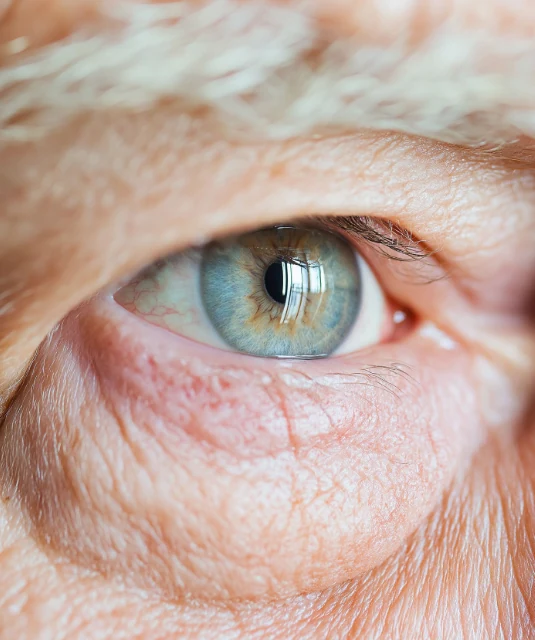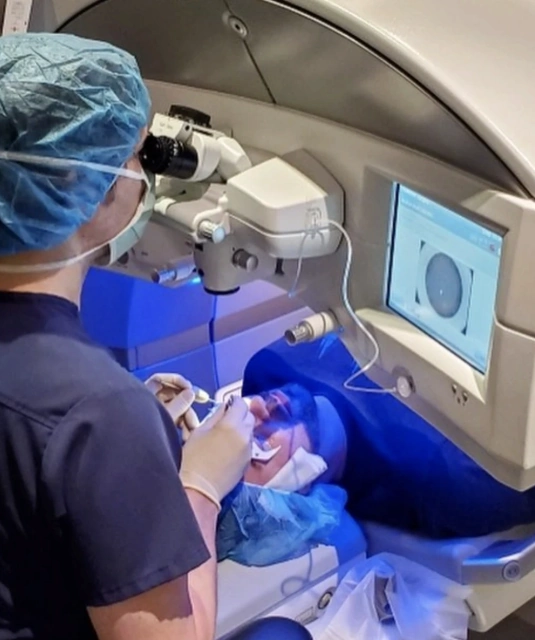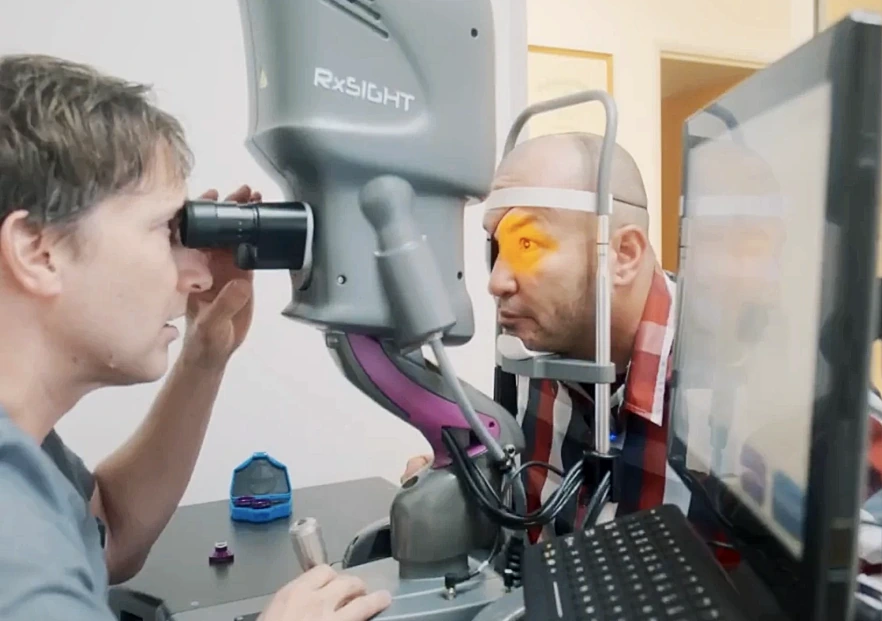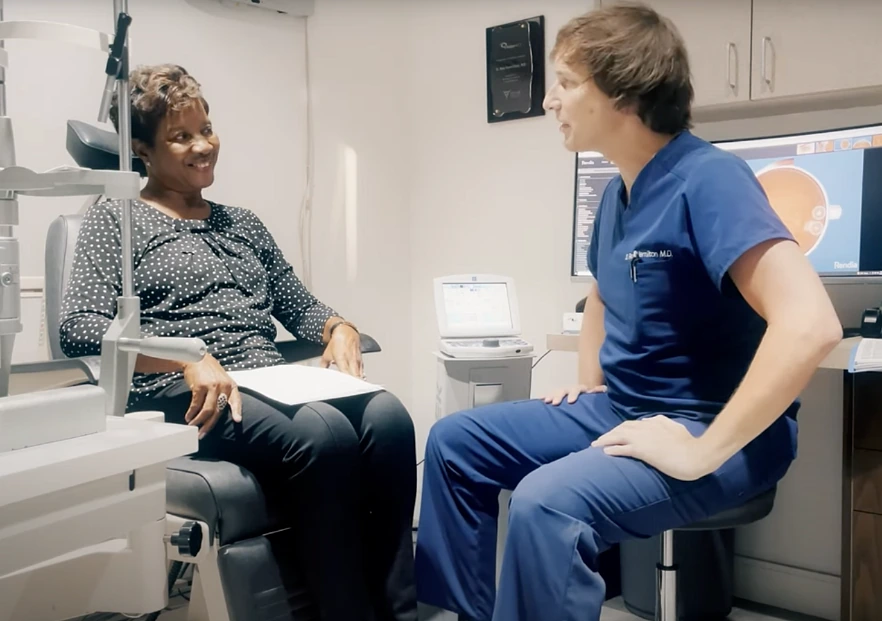
Cataract Surgery in Beverly Hills & Los Angeles: Advanced Vision Restoration
Last Updated: October 8, 2025
Medically Reviewed by: Rex Hamilton, MD, MS, FACS – Board-Certified Ophthalmologist

If you’re experiencing cloudy or blurry vision in Beverly Hills or Los Angeles, you may be dealing with cataracts—one of the
Trusted Source
Beyond vision:Cataract and health status in old age, a narrative review
Frontiers in Medicine
Go to Source
most common
age-related eye conditions.1 At Hamilton Eye Institute, Dr. Rex Hamilton brings over 25 years of ophthalmology experience and advanced laser cataract surgery techniques to patients throughout the greater Los Angeles area.
Cataracts affect everyone, with more than half of all Americans having been diagnosed with cataracts or having had cataract surgery by
Trusted Source
Cataracts
National Eye Institute
Go to Source
age 80.
Our Beverly Hills practice specializes in state-of-the-art cataract removal using femtosecond laser technology and premium intraocular lens (IOL) options to restore clear vision and reduce dependence on glasses.
- What Are Cataracts?
- Common Causes of Cataracts
- Recognizing Cataract Symptoms
- When Do You Need Cataract Surgery?
- Advanced Cataract Surgery Options in Beverly Hills
- What to Expect During Cataract Surgery
- Insurance Coverage and Transparent Pricing
- Recovery and Post-Operative Care
- Practice Statistics & Outcomes
- Potential Risks and Complications
- Why Choose Hamilton Eye Institute for Cataract Surgery?
- Lifestyle Factors That Accelerate Cataract Development
- Combining Cataract Surgery with Other Procedures
- Frequently Asked Questions

What Are Cataracts?
Cataracts occur when the natural lens of your eye becomes cloudy, blocking light from reaching the retina and causing vision problems. Think of it like looking through a foggy window—everything appears blurred, dim, or distorted.
Common Causes of Cataracts
While everyone develops cataracts due to aging, several factors can accelerate their development:
- Natural aging process – Proteins in the eye’s lens break down over time
- UV radiation exposure – Prolonged sun exposure without protection
- Smoking and alcohol consumption
- Diabetes and other medical conditions
- Genetic predisposition
- Eye injuries or previous eye surgeries
- Certain medications, particularly long-term steroid use
Cataracts are the leading cause of blindness
Trusted Source
Blindness due to cataract: epidemiology and prevention
Annual Review of Public Health
Go to Source
worldwide,
though they are highly treatable with surgery.
Recognizing Cataract Symptoms
Cataracts typically develop gradually, and symptoms may include:
- Blurry or cloudy vision
- Increased sensitivity to light and glare
- Difficulty seeing at night or in low light
- Seeing halos around lights
- Colors appearing faded or yellowed
- Frequent changes in eyeglass prescriptions
- Double vision in one eye
If you’re experiencing any of these symptoms in the Beverly Hills or Los Angeles area, it’s important to schedule a comprehensive eye examination to determine if cataracts are affecting your vision.

When Do You Need Cataract Surgery?
If you are in the over-60 age range, you are already suffering to some level from the debilitating effects of cataracts (poor night vision, changing glasses prescription, difficulties in dim light). Every patient over 60, therefore, would benefit from replacing the aging lens with a clear, advanced IOL to regain visual function and, as a huge side benefit, reduce dependence on glasses. By replacing the natural lens, you will never experience the increasing visual difficulties that occur as the cataract becomes worse. Severe (opaque) cataracts are the leading cause of blindness worldwide, as many parts of the developing world lack access to life-changing cataract surgery.
The decision to undergo cataract surgery is ultimately yours, based on how cataracts impact your daily activities and quality of life.
Surgery is recommended when:

- Vision problems interfere with daily activities like reading, driving, or working
- Cataracts affect your ability to perform job-related tasks
- You experience difficulty with night vision or driving
- Glare and light sensitivity become problematic
- Your quality of life is significantly impacted
Cataract surgery has a success rate of
Trusted Source
Effect of increasing age on cataract surgery outcomes in very elderly patients
The BMJ
Go to Source
over 95%
in improving vision and patient satisfaction.
In addition to cataract surgery, Dr. Hamilton is an expert in RLE surgery, which, when performed earlier in life (under 60 years old), prevents the development of cataracts and the visual difficulties they cause.
Advanced Cataract Surgery Options in Beverly Hills
Laser-Assisted Cataract Surgery
At Hamilton Eye Institute, we utilize advanced femtosecond laser technology for precise, customized cataract removal. This state-of-the-art approach offers several advantages over traditional methods:
- Enhanced precision – Computer and image-guided laser creates exact incisions
- Reduced surgical trauma – Gentler on surrounding eye tissues
- Improved outcomes – More predictable results and faster healing
- Customized treatment – Tailored to your unique eye anatomy
- Intraoperative aberrometry – Optical measurements taken once the cataract has been removed, prior to implantation of the IOL; this allows added precision in choosing the optimal IOL for each individual eye
We offer several leading laser platforms to accommodate each patient’s needs, including:
- Ally™ (LENSAR)
- Catalys™ (Johnson & Johnson)
- LenSx® (Alcon)
- ORA SYSTEM® intraoperative aberrometry (Alcon)
These technologies help us deliver safer, more accurate, and highly personalized cataract procedures.
Traditional Cataract Surgery
For patients who are candidates for conventional surgery, we also offer traditional phacoemulsification, which uses ultrasound energy to break up and remove the cloudy lens. This time-tested approach remains highly effective and safe.
Monofocal IOLs
This basic lens has been used for decades in cataract surgery. The monofocal IOL corrects one level of vision, does not correct astigmatism, and will require glasses to achieve the best quality and widest range of vision.
Premium Intraocular Lens (IOL) Options
One of the most exciting aspects of modern cataract surgery is the ability to choose from various premium IOL options that can address multiple vision problems simultaneously:
Light Adjustable Lens (LAL)
The revolutionary Light Adjustable Lens (RXSight) enables post-surgical vision optimization through specialized light treatments. This technology enables fine-tuning of your vision after surgery for optimal results.
Toric IOLs
Specifically designed for patients with astigmatism, toric lenses correct both cataracts and astigmatism simultaneously, providing clearer, sharper vision. Toric IOLs are available in multifocal, EDOF, or monofocal versions.
Multifocal/Extended Depth of Focus (EDOF) IOLs
These advanced lenses provide clear vision at multiple distances—near, intermediate, and far—potentially reducing or eliminating the need for reading glasses or bifocals.
We offer a full range of FDA-approved multifocal and EDOF intraocular lenses to meet individual visual needs and lifestyle preferences. Available options include:
-
- TECNIS Odyssey™ (Johnson & Johnson)
- TECNIS Symfony® (Johnson & Johnson)
- Clareon® PanOptix® Pro (Alcon)
- Clareon® Vivity™ (Alcon)
- Envista® Envy™ (Bausch + Lomb)
- ClearView™ (LENSTEC)
Dr. Hamilton will help you choose the IOL best suited to your eyes and daily activities for optimal visual performance.

What to Expect During Cataract Surgery
Cataract surgery is typically performed as an outpatient procedure and takes approximately 5-10 minutes per eye. Here’s what you can expect:
Pre-Operative Preparation
- Comprehensive eye examination
- Biometry measurements: these ultra-precise measurements document the dimensions of the eye structures from front to back and are used to calculate the correct IOL power for implantation in each eye
- Corneal tomography measurements: these measurements generate a three-dimensional representation of the cornea (front window of the eye) and allow for precise correction of astigmatism
- Discussion of IOL options based on your lifestyle needs
- Pre-surgical instructions and medication guidelines
- Arrangement for transportation on surgery day
During Surgery
- Local anesthesia to ensure comfort
- Small incision creation (laser or traditional)
- Removal of the cloudy natural lens
- Treatment of astigmatism
- Insertion of your chosen IOL
- Self-sealing incision that typically requires no stitches
Cataract Surgery Costs and Transparent Pricing

Insurance Coverage
Most insurance plans, including Medicare, cover non-laser, basic cataract surgery and standard monofocal IOLs. Coverage typically includes:
- Pre-operative examination and measurements
- Standard cataract surgery procedure
- Monofocal IOL implantation
- Post-operative follow-up visits for 90 days
Cataract Surgery Pricing (with Monofocal Lens)
Typically covered by Medicare and most insurance plans; out-of-pocket costs will vary based on your deductible and co-insurance.
Premium Intraocular Lenses (IOLs)
$3.500 – $8,500 per eye, depending on lens selection.
Flexible Financing
Payment plans are available through Alphaeon® Credit to help make advanced vision correction more accessible.
Recovery and Post-Operative Care
Immediate Recovery (First 24-48 Hours)
Most patients experience significant vision improvement within the
Trusted Source
Visual acuity recovery rates following cataract surgery and implantation of soft intraocular lenses
Journal of Cataract & Refractive Surgery
Go to Source
first few days
after surgery. You may experience:
- Mild discomfort or scratchiness
- Light sensitivity
- Slightly blurry vision as your eye heals
- Watery eyes
Short-Term Recovery (1-2 Weeks)
Most patients with mild cataracts can return to normal daily activities within 1-3 days after cataract surgery, with full recovery typically occurring within 1-2 weeks, depending on their occupation and healing progress. The more advanced the cataract, the more ultrasound/vibrational energy is required to remove it. Consequently, the cornea (window on front of eye) will be cloudier and take longer to clear in patients with more advanced cataracts. This translates to a longer time for vision to recover. This concept highlights another advantage to removing cataracts sooner than later.
Long-Term Healing (1-3 Months)
While visual acuity typically becomes stable after 1-2 weeks, the brain continues to adapt and learns how to use the new optics associated with the implanted IOL over the first few months. For example, night halos associated with multifocal/EDOF IOLs become less noticeable over the first 1-3 months.
Post-Operative Care Instructions
- Use prescribed eye drops as directed
- Avoid rubbing or pressing on your eye
- Wear a protective eyeshield when sleeping for the first week
- Avoid strenuous activities for the first week
- Attend all scheduled follow-up appointments
- Protect your eyes from bright sunlight
Practice Statistics & Outcomes
- Total cataract surgeries performed annually: 500-600
- Patient satisfaction rate: 98%
- Complication rate: <1%
- Patients achieving 20/20 vision or better: 95%*
- Average recovery time: 1-2 days**
- Revision surgery rate: 1%
*For patients with healthy eyes and no other vision-limiting conditions (e.g., macular degeneration, glaucoma, corneal scarring, diabetic retinopathy).
**Typical timeframe for achieving 20/40 or better vision after cataract surgery.
Potential Risks and Complications
While cataract surgery is considered one of the safest surgical procedures, it’s important to understand potential risks. Serious complications occur in
Trusted Source
Cataracts: Complications within 30 Days Following Cataract Surgery Requiring Additional Surgical Procedures
eQUI Resource Center
Go to Source
less than 1%
of cases and may include:
Rare but Serious Complications (< 1% incidence):
- Endophthalmitis (infection): 0.16% incidence rate
- Retinal detachment: 0.26% incidence rate
- Severe vision loss:
Trusted Source Estimating the rate of severe visual loss (wipe-out) following cataract surgery, a British Ophthalmological Surveillance Unit (BOSU) study Eye Go to Source < 0.0003%
incidence rate
More Common Minor Complications (1-5% incidence):
- Temporary increased eye pressure: Usually resolves within 24-48 hours
- Mild inflammation: Managed with prescribed eye drops
Our Complication Prevention Protocols:
- Pre-operative antibiotic prophylaxis
- Sterile surgical environment and techniques
- Advanced laser technology for precision
- Comprehensive post-operative monitoring
- 24/7 emergency contact availability
“Secondary” Cataract (10-50%)
- Posterior capsule opacification (PCO): 10-50% of patients may develop this “secondary cataract” months to years after surgery
- PCO: not the cataract returning or a degradation of the IOL
- PCO: scarring of the patient’s tissue, known as the capsule, from which the cataract was removed, and into which the IOL is placed
- PCO: easily treated with an in-office YAG laser that takes 2 minutes with no post-operative downtime and no risk of infection
- PCO does not return after YAG laser treatment
Frequently Asked Questions
Hamilton Eye Institute, conveniently located in Beverly Hills, serves patients throughout Los Angeles County and beyond. Dr. Hamilton’s extensive experience, advanced laser technology, and comprehensive IOL options make our practice a premier destination for cataract surgery. We offer personalized consultations to determine the best treatment approach for your unique vision needs and lifestyle goals.
Yes, cataract surgery can often be combined with other vision correction procedures. Popular combinations include astigmatism correction with toric IOLs, presbyopia treatment with multifocal lenses, and glaucoma management procedures. Dr. Hamilton will evaluate your complete eye health during consultation to determine if combination treatments are appropriate for your situation.
Cataract surgery results are permanent—cataracts cannot return once the natural lens is removed and replaced with an IOL. However, most patients may develop posterior capsule opacification (PCO), sometimes called a “secondary cataract,” which can be easily treated with a quick, 2-minute in-office laser procedure.
Cataract surgery is typically painless due to local anesthesia. Most patients report minimal discomfort, typically mild pressure, during the procedure and mild irritation during the first day or two of recovery. Any discomfort is usually well-managed with prescribed eye drops and over-the-counter pain relievers.
The optimal timing for second eye cataract surgery is typically 1-2 weeks after the first eye, once initial healing is confirmed and vision has stabilized. Dr. Hamilton will assess your individual healing progress to determine the best timing for your second procedure.
Lifestyle Factors That Accelerate Cataract Development
Understanding and modifying certain lifestyle factors may help slow cataract progression:
Protective Measures
- UV protection – Wear sunglasses with 100% UV protection
- Smoking cessation – Smoking significantly increases cataract risk
- Diabetes management – Proper blood sugar control reduces complications
- Nutrition – Antioxidant-rich foods may provide protective benefits
- Regular eye exams – Early detection allows for better management
Combining Cataract Surgery with Other Procedures
Many patients in Beverly Hills and Los Angeles choose to combine cataract surgery with other vision correction procedures:
Simultaneous Treatments
- Astigmatism correction with toric IOLs or limbal relaxing incisions
- Presbyopia treatment with multifocal or accommodating IOLs
- Glaucoma management with combination procedures
Why Choose Hamilton Eye Institute for Cataract Surgery?
Advanced Technology and Techniques
Our Beverly Hills practice and surgery center feature:
- State-of-the-art femtosecond laser systems and intraoperative aberrometry
- Comprehensive IOL options, including the latest premium lenses
- Advanced diagnostic equipment for precise surgical planning
- Comfortable, modern facility

Personalized Patient Care
We understand that each patient’s vision needs are unique. Our approach includes:
- Thorough consultation and examination
- Detailed discussion of all treatment options
- Firm recommendation as to best option
- Customized surgical planning
- Comprehensive post-operative care
- Ongoing support throughout your recovery

Convenient Beverly Hills Location
Hamilton Eye Institute
8900 Wilshire Blvd, Suite 300A
Beverly Hills, CA 90211
Phone: (424) 732-2020
Office Hours:
Monday – Friday | 8:00 AM – 5:00 PM
Parking
Valet service available with accessible options.
Emergency Care and After-Hours Support
After-hours communication is available exclusively for post-surgical patients through our HIPAA-compliant Spruce system, which allows secure phone and text messaging. All other patients with urgent medical concerns should contact 911 or visit the nearest emergency department or urgent care clinic.
Hamilton Eye Patient Reviews
About Dr. D. Rex Hamilton:
Your Cataract Surgery Specialist
Dr. Hamilton brings exceptional qualifications and extensive experience to patients seeking cataract surgery in Beverly Hills and Los Angeles:

Professional Experience & Training
- Over 25 years of ophthalmology experience
- Board-certified ophthalmologist with specialized training in cataract and refractive surgery
- Ophthalmology residency completed at UCLA Stein Eye Institute
- Fellowship training in advanced cataract and refractive surgery following residency at Minnesota Eye Consultants with Dr. Richard Lindstrom
- Former UCLA faculty – Professor of Ophthalmology at the UCLA Stein Eye Institute
- Former Director of the UCLA Laser Refractive Center
Professional Credentials & Certifications
- Medical Degree: MD, MS, FACS (Fellow of the American College of Surgeons)
- Board Certification: American Board of Ophthalmology
- Professional Association Memberships:
- American Society of Cataract and Refractive Surgery (ASCRS) – Published contributor and active conference faculty member
- American Academy of Ophthalmology – Published contributor and active conference faculty member
- Fellow of World College of Refractive Surgery & Visual Sciences
- Refractive Surgery Alliance member
- American-European Congress of Ophthalmic Surgery member
Published Research & Academic Contributions
Dr. Hamilton has been a senior or contributing author on more than 30 peer-reviewed publications in ophthalmology, including the following, which directly relate to cataract surgery:
- Method for Intraocular Lens Power Calculation in the Second Eye of Patients with Previous Keratorefractive Surgery. Journal of Refractive Surgery (2020)
- Prevention and Management of Refractive Prediction Errors Following Cataract Surgery. Journal of Cataract & Refractive Surgery (2020)
- Medical and surgical management of the small pupil during cataract surgery. Journal of Cataract & Refractive Surgery (2018)
- Frequently Asked Questions About Small Incision Lenticule Extraction (SMILE). Cataract & Refractive Surgery Today (2019)
- Perioperative Assessment for Refractive Cataract Surgery. Journal of Cataract & Refractive Surgery (2016)
- Surgical Correction of Presbyopia. Journal of Cataract and Refractive Surgery (2016)
- Effect of Posterior Corneal Astigmatism on Refractive Outcomes after Cataract Surgery with Toric Intraocular Lens Implantation. Journal of Cataract and Refractive Surgery (2015)
- Toric IOLs for Irregular Astigmatism – Cataract & Refractive Surgery Today (2014)
- Femtosecond Laser-Assisted Cataract Surgery. Journal of Cataract & Refractive Surgery (2013)
- Authored 15 book chapters in foundational ophthalmology textbooks
- Presented more than 50 peer-reviewed scientific papers at national and international ophthalmology conferences, including ASCRS, AAO, ESCRS
- Delivered more than 250 invited lectures at educational conferences and meetings around the world
Medical Disclaimer and Editorial Review
Medical Disclaimer: This information is for educational purposes only and should not replace professional medical advice. Individual results may vary. Consult with Dr. Hamilton for personalized treatment recommendations based on your specific condition.
Editorial Review Process: This content has been medically reviewed by Dr. D. Rex Hamilton, MD, MS, FACS, and is updated regularly to reflect current medical standards and practice protocols.
Publication Information:
Originally Published: August 11, 2025
Last Updated: August 11, 2025
Next Review Date: July 17, 2026
Medical Reviewer: D. Rex Hamilton, MD, MS, FACS
1 Frontiers in Medicine. Beyond vision:Cataract and health status in old age, a narrative review. https://pmc.ncbi.nlm.nih.gov/articles/PMC10061098/. Accessed July 18, 2025.
2 National Eye Institute. Cataracts. https://www.nei.nih.gov/learn-about-eye-health/eye-conditions-and-diseases/cataracts. Accessed July 18, 2025.
3 Annual Review of Public Health. Blindness due to cataract: epidemiology and prevention. https://pubmed.ncbi.nlm.nih.gov/8724222/. Accessed July 18, 2025.
4 The BMJ. Effect of increasing age on cataract surgery outcomes in very elderly patients. https://pmc.ncbi.nlm.nih.gov/articles/PMC1120237/. Accessed July 18, 2025.
5 Journal of Cataract & Refractive Surgery. Visual acuity recovery rates following cataract surgery and implantation of soft intraocular lenses. https://pubmed.ncbi.nlm.nih.gov/2040971/. Accessed July 18, 2025.
6 eQUI Resource Center. Cataracts: Complications within 30 Days Following Cataract Surgery Requiring Additional Surgical Procedures. https://ecqi.healthit.gov/sites/default/files/ecqm/measures/CMS132v7.html. Accessed July 18, 2025.
7 Eye. Estimating the rate of severe visual loss (wipe-out) following cataract surgery, a British Ophthalmological Surveillance Unit (BOSU) study. https://pubmed.ncbi.nlm.nih.gov/37328508/. Accessed July 18, 2025.